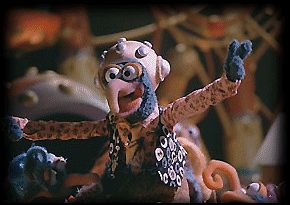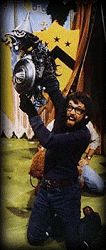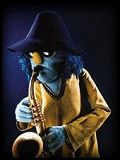| A
R T I C L E S |
New Collectibles •05/25 - NECA Sesame Street: Count Von Count Ultimate Action Figure
•04/25 - Reaction Sesame Street: Big Bird and Snuffy •03/25 - NECA Sesame Street: Ernie Ultimate Action Figure, Bert Ultimate Action Figure
•03/25 - Boss Studios Fraggle Rock: Boober Action Figure, Wembley Action Figure, Mokey Action Figure, Sprocket Action Figure •08/24 - Reaction Sesame Street: Big Bird, Mr. Hooper, Sherlock Hemlock, Super Grover |
||
|
|
|

GOELZ: When I returned to New York in September of 1974 we started working on the "Sex & Violence" special, which was shot in January of 1975. One of the things I got to do was perform Zoot, the sax player in the Dr. Teeth and the Electric Mayhem Band. It was a vicarious thrill. Our first number was shot with lots of lighting effects and quick cutting, and I loved pretending to be a rock performer. This part of performing appealed to me; it offered the chance to live out fantasies. ABC did not pick up the series, and after a summer in which we guested on a couple of Cher shows, Lew Grade suggested that the Muppets create a syndicated series, to be shot at his ATV Studios north of London. These developments were all terribly exciting for us.
Were you given Gonzo right off the bat, or did they say, "Pick which puppet you'd like to do?"
 |
| Dressed in style, Gonzo sings with his alient brothers in Muppets From Space. |
GOELZ: No, Jim actually asked me to do Gonzo. Originally, he was conceived as a character who does really awful acts and thinks they're art. Jim chose that particular puppet from the stockpile. That puppet had appeared several years before as a character named "Cigar Box Frackle" in a special called "The Santa Clause Switch." The character of Gonzo was conceived by Jerry Juhl and might have been forgotten about during the early meetings, except that Jack Burns - who was head writer on the first season - said, "Yeah! Yeah! Like he does these crazy acts like eating a tire to 'Flight of the Bumblebee!" I guess that sentence inspired the writers, so Gonzo ate his tire in the first episode and grew from there.
How difficult was it to perform Gonzo in the beginning, when his eyes were not moveable, and they were locked into a downcast expression?
GOELZ: The downcast eyes made him easy to play, because that was exactly how I felt. I was an impostor in show business. I was learning how to perform and to puppeteer on the job. Our guests were the top television, stage, film and music stars of the time, and it was intimidating to watch them ply their craft. I had literally just stepped into this world from my neighborhood, without any training or dues paying, so it was easy to play Gonzo as a downcast character.
The whole first season, I only got one laugh out of the crew. It was painful. ATV Studios was one of the premier television production centers in the world, and the crew was used to doing high-profile shows. They had seen it all. They loved watching Jim and Frank work. When I came onstage, I could hear the newspapers come up. I knew they were thinking "The cub is coming we're gonna be bored for the next 45 minutes." But near the end of the season, a miracle happened. I got one laugh, by over-emphasizing the word (in Gonzo voice) "Nnoooo!" So I sort of went away from the first season with my laugh and thought, "Gee, it seems like when he got excited, it was funny. But I can't make this character look excited, because his eyes don't open." When we returned to New York, Jim allowed me to make a new Gonzo that had an eye mechanism. So I just breezed right into the second season and got another laugh. Two laughs in two years, now I was really on a roll!
The second season was when Gonzo really started to become a core character, and it seemed to be cemented in the third season, as well as in the movie...
 |
| In the Pearl Bailey episode, Gonzo prepares for the joust at Camelot. |
GOELZ: To me, it was just a progression. There were a few milestones. Once he became excitable it was much easier to make him interesting, because he could show a range of emotions. A pivotal moment was when he tried to put together a dancing chicken act. There were some scenes in which he was auditioning chickens backstage, and I ad-libbed a line that has formed a large part of his character ever since. As usual, Mike the animal trainer promised that the chickens would be able to do whatever we asked as long as he had three weeks to train them. So he got his three weeks, and when they came in, they wouldn't dance. Not one step. By the way, Jim had a thing about chickens. He just thought they were hysterical. That's why we were using them. So we were shooting, and Gonzo says stuff like, "Do a little timestep for me." And the chicken just stands there. "Well, how about a pirouette? Do something. Anything." The chicken just stands there. Finally, the chicken turned around and walked out, and Gonzo called after her "Don't call us, we'll call you." Then he turned to the camera and said, "Nice legs though!" Jim cracked up. That weird attraction to chickens just made him so strange, and it was something Jim liked a lot. So Gonzo soon got a chicken girlfriend, Camilla. Whenever it came time to shoot with Camilla, we could never remember what color her eyes were. Sometimes we used blue, sometimes green, and so forth. So Jim and I developed this theory that Gonzo actually couldn't tell the difference between the chickens, and whatever chicken he could get to come along with him, he would call Camilla. Chickens, being limited intellectually, were happy to go along with this.
Of all the characters you performed on "The Muppet Show," which was your favorite? I've heard you talk negatively of Zoot in the past, and I was just wondering...
 |
| It is the unspoken words of Zoot which give the character his charm. |
GOELZ: The funny thing about Zoot was that I was about 26-27, and we always conceived of him as a 50 year-old, burnt-out musician. Now I'm 53, and I still can't play him - probably because I'm still locked into the Zoot I played from the beginning. If I started fresh it would certainly be easier at this point in my life. Anyway, I had a conception of him as a guy who was totally into his music, who lived in a succession of hotels, who had never had a home... his life was just music. And he was just spaced out all the time. He had no ability to communicate with people using words. As a result, whenever they scripted lines for him, I tried to give them to Floyd. I was always trying to give away lines, because I didn't know how to do him. The irony was, after I did this for awhile and Zoot became established as a rather silent character, people started coming to me and saying, "You know, that Zoot is amazing. I know somebody just like him."
Sammy Cahn came up to me during the party after the British premiere of The Muppet Movie and said, "You do Zoot? He is fantastic! I've known so many sax players just like him." I was bowled over; The only sax player I knew was Frank Reedy, of the Jack Parnell Orchestra, the musicians for the Muppet Show, and he wasn't anything like Zoot. I didn't follow or study sax players or read about them - all I was doing was trying to avoid doing the character, and here was Sammy Caan, telling me I'd got it nailed. So it was just a lucky break. But to answer your question, Gonzo is my favorite among The Muppet Show characters. Having said that, I should mention that there is great joy in switching among many characters. It gives vent to many aspects of your personality. I perform several characters on "Fraggle Rock," "The Secret Life of Toys" and "Jim Henson's Animal Show with Stinky and Jake." The variety is very stimulating.
How did the big Gonzo scenes in "The Muppet Movie" come about? I am speaking of "I'm Going To Go Back There Someday"...
 |
| Gonzo ponders buying Camilla some balloons in The Muppet Movie. |
GOELZ: There's a bit of a story about that. Originally, no song was planned for that moment in the film, but Paul Williams had a strong identification with Gonzo. He said, "Gonzo reminds me of a flightless bird, and for me that's where his pathos comes from." So he wrote this incredible set of lyrics about yearning to reconnect with something. Jim and Jerry Juhl decided to use the song at the bleak moment when all the characters are stuck in the desert. Gonzo's song re-inspires Kermit to continue his quest. This all happened without me. I was in California preparing to build my house. I showed up the read-through and everyone said "Wow, you've got this incredible song."
Were there any guests that you really enjoyed working with on "The Muppet Show?"
GOELZ: First let me say that they all impressed me. The level of professionalism was overwhelming. I hadn't been around entertainers before. These people would have a few telephone discussions before flying to London. They would arrive on a Saturday morning after flying all night long and go to a costume fitting and a meeting with Jim and David Lazer. Sunday we would have a read-through and rehearsal and modify the script according to their needs. Monday we would record music - band in the morning, vocals in the afternoon. The guests would shoot their material on Tuesday and then they would be gone - poof. In the course of four days they had created these awesome performances completely from thin air. That amazed me.
How many of the guests actually stayed around for the rest of the week?
 GOELZ:
None. They had places to go, and they were like I am now. We're working
right next door to "Dawson's Creek" and I've got neighbors in California
who love the show. Have I walked onto their stage once? No. It doesn't
even occur to me. When I was a kid, I used to live in Burbank, California,
and all I could think of was to get inside Disney or Warner Brothers studios
and look around. It's just that when you work around it all the time,
you're less curious. Brooke Shields was 15 when she guested on "The Muppet
Show" and it was very interesting, because she had been marketed as a
prodigy, yet she was just a girl when she was with us. All she wanted
to do between shots was go back to the workshop and make puppets, and
that's what she did. Another who hung out in the workshop was Phyllis
Diller. She was such a nice lady and funny and fun to be with. Instead
of going to her dressing room, she'd come to the workshop and just visit.
Peter Sellers was a huge treat for me to work with. I forget which season
that was in...
GOELZ:
None. They had places to go, and they were like I am now. We're working
right next door to "Dawson's Creek" and I've got neighbors in California
who love the show. Have I walked onto their stage once? No. It doesn't
even occur to me. When I was a kid, I used to live in Burbank, California,
and all I could think of was to get inside Disney or Warner Brothers studios
and look around. It's just that when you work around it all the time,
you're less curious. Brooke Shields was 15 when she guested on "The Muppet
Show" and it was very interesting, because she had been marketed as a
prodigy, yet she was just a girl when she was with us. All she wanted
to do between shots was go back to the workshop and make puppets, and
that's what she did. Another who hung out in the workshop was Phyllis
Diller. She was such a nice lady and funny and fun to be with. Instead
of going to her dressing room, she'd come to the workshop and just visit.
Peter Sellers was a huge treat for me to work with. I forget which season
that was in...
Second season, I believe...
GOELZ: That sounds right. Remember, during the second season I'm on my way to getting my second laugh. He came in, and he really wanted to do something with Gonzo, because he loved the character. He felt that Gonzo was like Clouseau in his lack of self-awareness. This was great validation for me, because Peter Sellers was one of my idols. I'd grown up watching the "Pink Panther" films and loving his work, so when he came in and was excited about working with me, I was in shock. It was really weird now that I think back on it, but it was great.
|
|
|
home | news | collectibles | articles | forum | guides | radio | cards | help
Fan site Muppet Central created by Phillip Chapman. Updates by Muppet
Central Staff. All Muppets, Bear
Muppet Central exists to unite fans of the Muppets around the world. |